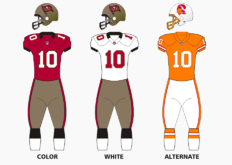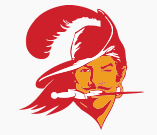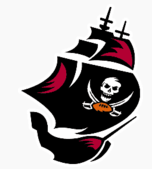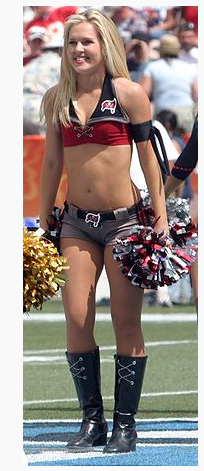
In the first day of the NFL Free Agency period, the Buccaneers signed two out of the top 3 free agents available: WR Vincent Jackson, G Carl Nicks and alongside them, CB Eric Wright. The total of $140 million dollars committed to the team during that 24-hour period is considered the largest investment the Glazer family has put into the team going back almost a decade.
The Buccaneers would finish the 2012 season with a 7–9 record. Notably, the Buccaneers finished first against the run in the NFL and had three pro-bowlers, WR Vincent Jackson, DT Gerald McCoy and RB Doug Martin.
Team facilities
Since 1998 the Buccaneers have played their home games at Raymond James Stadium in Tampa. Prior to that they played in Tampa Stadium since their establishment.
In 1975, the Buccaneers built a small practice complex with offices near Tampa International Airport called One Buccaneer Place. As other NFL teams upgraded their facilities, Bucs players and coaches stepped up their complaints about the aircraft noise, cramped offices, small locker rooms and run-down condition of One Buc Place. Even then-head coach Jon Gruden has sarcastically referred to the facility as "The Woodshed." For much of the team's existence, the Bucs held training camp on the University of Tampa campus, then at the expansive and better-equipped Disney's Wide World of Sports Complex near Orlando (2002—2008).
In August 2006, the Bucs unveiled their new training facility. Conveniently located across the street from Raymond James Stadium (on the former site of Tampa Bay Center), this state-of-the-art complex (145,000-square-foot (13,500 m2) facility on 33 acres (13 ha)) is the largest in the NFL. Its features include offices and meeting rooms, two natural grass practice fields, a theatre for meetings and press conferences, an expanded weight room, a fully equipped kitchen and dining room, a rehabilitation center with three separate pools and a locker room twice the size of the former location. The building is capped off with a giant five-story glass and steel football as a key design element. A third practice field, featuring artificial turf, was also planned. In 2009, the team began holding training camp at the new upgraded facilities in Tampa.
In the second week of September 2007, statues of important figures from the Bucs 2002 Championship season were moved into the lobby area in an exhibit called "Moment of Victory". The life-size statues included players Mike Alstott, Ronde Barber, Derrick Brooks, Brad Johnson, John Lynch, Shelton Quarles, Simeon Rice, Warren Sapp, and head coach Jon Gruden. The statues are modeled after images from the sideline towards the end of Super Bowl XXXVII.[25]
Practices at the currently unnamed facility will remain closed to the public, although the existing mall parking on the west side of the property is still available for use on game days. The facility is still referred to as One Buc Place, or sometimes by local media as One Buc Palace.
Logos and uniforms
1976–1996

Tampa Bay uniforms worn in the 2012 season, including the throwback orange uniform.

The original Bucs logo (1976–1996), nicknamed "Buccaneer Bruce"

Bucs alternate logo (1997–current), with "Skulls and Swords" aboard pirate ship
When the team began play in 1976, Culverhouse initially picked team colors of red, green, orange and white. However, the shade of green was too close to that used by the Miami Dolphins. A medium shade of "Florida Orange" was substituted for green. Home uniforms included orange jerseys with white numerals outlined in red—the now-infamous "Creamsicle" uniforms. Road white jerseys originally had orange numerals outlined in red, but these colors were reversed for year two and beyond. The color swap provided better visibility, especially for television coverage purposes.
Long-time Tampa Tribune cartoonist and Ye Mystic Krewe of Gasparilla member Lamar Sparkman designed the first team logo.[26] Faced with the difficulty of designing a logo that did not closely resemble that of the other "pirates" in the league, the Oakland Raiders, Sparkman came up with a pirate in a plumed hat and a dagger in his mouth. The pirate appeared to be winking. He came to be known as "Bruce the Buccaneer" or "Buccaneer Bruce" (sometime shortened to "Bucco Bruce"). Sports writer and commentator Nick Bakay once said that Buccaneer Bruce was a pirate who "struck fear in the hearts of no one."
However, there was controversy over where the cartoonist received inspiration for his Buccaneer. Beloit College, located in Beloit, Wisconsin, received a notice from the Tampa Bay Buccaneers of the college's illegitimate use of their mascot. Beloit College's buccaneer is the mirror image of the Tampa Bay buccaneer, with the creamsicle colors replaced with Beloit's school colors.[27] Athletic Director Ed DeGeorge said Beloit's Buccaneers have used the logo since the early 1980s, when he chose it from a book while ordering decals for the football team's helmets. The NFL's Buccaneers joined the league in 1976.[28] However, the Buccaneers withdrew their claim against Beloit College because of the independent decision to redesign the logo.
In 1992, the Buccaneers introduced orange pants to be worn with the white jerseys. Prior to the team's season finale in 1995 against the Lions, lame-duck coach Sam Wyche suggested that the Buccaneers wear the orange pants with their orange jerseys. The idea was vetoed by, among others, Pro Bowl linebacker Hardy Nickerson.
For the 1993 season, the Buccaneers added a commemorative patch to the right sleeve of their orange, away uniforms, which read, "Mr C" in cursive script.[29]
1997–present
For the 1997 season, the Glazers worked with the NFL to develop a more marketable and intimidating look in order to improve the team's image. The Buccaneers changed their team colors to red, pewter, black and orange. "Bucco Bruce" was replaced by a red flag displaying a white pirate skull and crossed sabres which is a modified Jolly Roger (similar to that of Calico Jack). The flag was mounted on another sabre. The "Buccaneers" team name was written in a new font, Totally Gothic, and was either red with shadows of pewter or red and white. Orange pinstriping, and an orange football, was used to maintain a visual link to the former colors.Chris Berman nicknamed them "the pirates in pewter pants," a play on the Gilbert and Sullivan opera The Pirates of Penzance. The Buccaneers planned to stage a ceremony in which Bruce was to walk the plank of a pirate ship in Tampa Bay, but he was pardoned at the last minute by Governor Lawton Chiles.
The new uniforms were adopted while Raymond James Stadium was still under construction, and the new colors would be prominent at the new facility. This new color scheme closely resembled that of the Tampa Bay Bandits, the USFL team that played in the region from 1983 to 1985 and had a color scheme of red, silver, black and white.
The new uniforms provided a combination of either red or white jerseys with either pewter or white pants. The red-on-white combination has been used sparingly, but was brought back for a SNF home game against the Seattle Seahawks in 2008; and it was worn again for a home game against the New Orleans Saints in 2009. In 2010, the Buccaneers wore the white pants primarily with both the red and white jerseys, but have since reverted to pewter pants with both jerseys under current head coach Greg Schaino.
In 2003, the Buccaneers introduced a practice jersey that featured orange piping. In 2004, a pewter practice jersey was used, with numerals in the Totally Gothic font.
Like many other NFL teams located in subtropical climates, the Buccaneers traditionally wear their white road jerseys at home during the first half of the season — forcing opponents to suffer in their darker colors during the hot summers and autumns in Tampa. Additionally, the visitors' bench of Raymond James Stadium is located on the east side of the stadium, which is in direct sunlight for 1 p.m. eastern games. The west sideline is in the shade. In the 1980s and in 1996, the last year of the original uniforms, the Bucs generally wore white at home for the entire season including preseason. Since the new uniforms were adopted, the Bucs wear the red jerseys for the final four home games, and for nearly all night home games. In the preseason, the Bucs typically wear white for one of their two home games. The Bucs have worn their red jerseys for all home postseason games except for a January 6, 2008 playoff match against the New York Giants, where the Bucs wore white, as the temperature that day was unseasonably high.
The Buccaneers' 1997 uniform change prompted a 2003 lawsuit by the Raiders, who claimed that the NFL and the Buccaneers had infringed upon key trademark elements of the Raiders' brand, including the Raiders' pirate logo. In the same suit, the Raiders challenged the Carolina Panthers' color scheme, which included silver and black. The Raiders wanted the courts to bar the Buccaneers and Panthers from wearing their uniforms while playing in California. However, since the lawsuit was filed in a state California court, the lawsuit was tossed out because only federal courts have jurisdiction on intellectual property issues.[30]
Throwback
Following the uniform change in 1997, the Buccaneers did not wear the old uniform, even during popular league-sponsored "throwback" weekends. Team merchandise in the old color scheme was also eliminated for several years. In 2008, the team revealed that they would be wearing the orange throwback uniforms for at least one game in the 2009 season.[31] Their use was in conjunction with the creation of a Buccaneers Ring of Honor, coinciding with the 30th anniversary of the 1979 division championship team.
Throwback merchandise went on sale in the summer of 2009, and referred to the orange color, not as "Florida Orange," but as "Orange Glaze." Considerable research was done using photographs and old uniforms to match the original color schemes. The dagger-biting pirate was given a cleaned-up look, and the orange, red and white uniforms debuted against the Green Bay Packers (Tampa Bay's former division rival) on November 8, 2009. Raymond James Stadium was also transformed via orange banners and classic field logos and fonts back to the classic Tampa Stadium look of the late 1970s. The Buccaneers won their first throwback game (their first victory of 2009) behind rookie quarterback Josh Freeman's first-career NFL start.[32] The single throwback uniform game has since become an annual tradition.
Defense
Throughout their history, the Buccaneers have been known for their suffocating defense. It started with the drafting of Hall of Fame defensive end Lee Roy Selmon with their first pick ever in 1976. 3 Bucs have won the AP Defensive Player of the Year award, and they have led the league in total defense 3 times. Both of the Buccaneers Pro Football Hall of Famers are defensive players.
1978-1982
Led by Selmon, Linebackers Dewey Selmon, Richard Wood, Dave Lewis, and Mike Washington, Mark Cotney, and Cedric Brown in the secondary, the early years Buccaneers quickly earned an identity as a defensive team. Their 3-4 defense peaked in 1979 when they led the league in total defense, points allowed, and first downs allowed. Lee Roy Selmon was voted NFL Defensive Player of the Year, but they eventually fell 10 points short of the Super Bowl as the offense held them back in the NFC Championship game in a 9-0 loss to the Los Angeles Rams.
1997-2008 The "Tampa 2"
By drafting franchise cornerstones John Lynch in 1993, and Warren Sapp and Derrick Brooks in 1995 to go along with All-Pro linebacker Hardy Nickerson, followed by the hiring of innovative defensive coordinator Monte Kiffin in 1996, the Buccaneers set the stage for one of the greatest defensive runs in NFL history. From 1997 to 2008, the Buccaneers defense finished in the league's top 10 every year but one, including 8 top 5 finishes, and 2 top ranked finishes. Kiffin along with Head Coach Tony Dungy created the "Tampa 2" defense known for its simple format, speed, and the aggressive mentality of its players. Kiffin's defenses were known as gang tacklers with tremendous team speed with a front 4 that could pressure the quarterback consistently, fast sideline to sideline linebackers, and a hard hitting secondary that caused turnovers. Many teams have copied the Tampa 2, but none have come close to the success of the Buccaneers as the the Buccaneers had either current or future Hall of Fame players in Warren Sapp, Derrick Brooks, John Lynch, Ronde Barber, and Simeon Rice performing as well as pro bowl players Hardy Nickerson, Donnie Abraham, and others.
2002 Defense
The 2002 Buccaneers defense is widely regarded as one of the greatest defenses in NFL history, rivaled only by the 2000 Ravens, 1985 Bears, 1976 Steelers, and few others. In the regular season the Buccaneers led the league in Total Defense (252.8 ypg), Points Allowed (196), First Downs Allowed (14.8 pg), Passing (155.6 ypg), Interceptions (31), Interception Touchdowns (5), opponent QB Rating (48.4), and Shutouts (2), as well as finishing 3rd in Opponent Rushing YPC (3.8), and 6th in Sacks (43). Linebacker Derrick Brooks was awarded AP Defensive Player of the Year as the defense led the way to a 12-4 regular season. As dominant as they were, they were even better in the postseason allowing only 37 points in 3 games combined all against top 10 offenses. In those 3 games, they intercepted 9 passes returning 4 for touchdowns and collected 11 sacks.
In Super Bowl XXXVII, the Buccaneers delivered one of the most dominant defensive performances in Super Bowl history. Playing against the #1 offense in the league led by league MVP Rich Gannon, the defense actually outscored the Raidersoffense limiting them to only 2 offensive touchdowns while returning 3 interceptions back for touchdowns. The defense set 2 records in the 48-21 blowout, one for most interceptions in a Super Bowl with 5, and one for most interceptions returned for touchdowns in a Super Bowl with 3. In 19 total games in 2002, the Buccaneers recorded 40 interceptions, 53 sacks, and 9 defensive touchdowns.
Facts and records
Losing streaks
The expansion Buccaneers lost all 14 games during the 1976 regular season, and the first 12 games of the 1977 season, for a record 26 straight losses. Even after the season expanded to 16 games in 1978, they remained the only NFL team in the modern era to experience a winless season until the Detroit Lions went 0–16 in 2008. A twenty-game road losing streak against AFC teams finally ended with a 17–10 victory over the Denver Broncos on December 26, 1993.[citation needed] In 1980, after beating the Bengals at Riverfront Stadium, the Buccaneers began a 27-game losing streak of games played outdoors on AstroTurf.[citation needed] The streak was broken in 1995, with a victory over the Eagles at Veterans Stadium. From their inception, they lost 20 consecutive games in which the temperature at kickoff was below 40 °F (4 °C). The streak ended in the final week of the 2002 regular season, when they beat the Bears at Champaign (Soldier Field was under renovation at the time).
Records
• Matt Bryant's 62-yard, game-winning field goal against the Eagles in 2006 was the second-longest game-winning field goal in NFL history. The NFL record is 63 yards.
• The Buccaneers are the first post-merger expansion team to win a division title, win a playoff game, and to host and play in a conference championship game. This was accomplished during the 1979 season.
• They are the first team since the merger to complete a winning season when starting 10 or more rookies, which happened in the 2010 season.[33]
• Until December 16, 2007, the Buccaneers were the only NFL team to have never returned a kick-off for a touchdown during the regular season. This distinction ended when Micheal Spurlock returned the 1,865th try 90 yards for the score during the week 15 game against the Atlanta Falcons.[34]
• The Buccaneers hold several distinctive NFL defensive streaks set during a period from 1999–2003.
• A record 69 consecutive games with at least one sack. The record (previously 68 by Dallas) was broken on November 9, 2003 against Carolina. The streak ended the following week on November 16, 2003 against Green Bay.
• 50 consecutive games with at least one sack and one forced turnover. The streak ended on November 16, 2003 against Green Bay.
• 54 consecutive games with at least one forced turnover (interception or forced fumble). The streak ended December 14, 2003 against the Texans. The all-time record was 71 consecutive games by the Eagles.
Retired numbers
| Tampa Bay Buccaneers retired numbers | ||||
|---|---|---|---|---|
| No. | Player | Position | Tenure | |
| 63 | Lee Roy Selmon | DE | 1976–1984 | |
| 99 | Warren Sapp [35] | DT | 1995–2003 | |
• 8 Steve Young, QB
• 63 Lee Roy Selmon, DE
• 64 Randall McDaniel, OG
• 99 Warren Sapp, DT
Tampa Stadium Krewe of Honor
In 1991, the organization initiated the "Krewe of Honor," which featured a mural of the first class of four members.[36] No additional members were added before Tampa Stadium was closed and demolished.
• Lee Roy Selmon
• John McKay
• Ricky Bell
• Doug Williams
Ring of Honor
On November 8, 2009, the team unveiled a new Ring of Honor at Raymond James Stadium.[37]
• 2009: Lee Roy Selmon (30th anniversary of the 1979 team)
• 2010: John McKay
• 2011: Jimmie Giles
• 2012: Paul Gruber (15th anniversary of the 1997 team)
• 2013: Warren Sapp
Pro Bowlers
Many former and current Tampa Bay Buccaneer players have represented the franchise in the Pro Bowl:
• Mike Alstott
• Ronde Barber
• Josh Bidwell
• Derrick Brooks
• Mark Carrier
• Jeff Christy
• Trent Dilfer
• Warrick Dunn
• Jeff Garcia
• Jimmie Giles
• Martín Gramática
• Wayne Haddix
• Vincent Jackson
• Brad Johnson
• Keyshawn Johnson
• Davin Joseph
• John Lynch
• Doug Martin
• Tony Mayberry
• Keenan McCardell
• Gerald McCoy
• Randall McDaniel
• Dave Moore
• Hardy Nickerson
• Dave Pear
• Donald Penn
• Shelton Quarles
• Simeon Rice
• Warren Sapp
• Lee Roy Selmon
• Clifton Smith
• James Wilder
Cheerleaders

Cheerleader in 2006 costume
The Bucs created an official cheerleading squad in their first season, called the "Swash-Buc-Lers." In 1999, they were renamed as the "Tampa Bay Buccaneers Cheerleaders."[38]
Radio and television
The Buccaneers' current flagship radio stations are WFUS 103.5 FM and WDAE 620 AM. The play-by-play announcer since 1989 has been Gene Deckerhoff. Former Bucs tight end Dave Moore joined Deckerhoff as analyst for the 2007 season. T. J. Rives works as the sideline reporter.
Broadcast legend and former Green Bay Packers' announcer Ray Scott was the play-by-play man for the Bucs' inaugural season of 1976, and from 1977 to 1988 Mark Champion, who became the voice of the Detroit Lions (1989–2004) and now the Detroit Pistons (2001–present), held that position with the Bucs.
Former Buccaneer Hardy Nickerson served as color commentator for one season in 2006, until he signed with the Bears as a linebackers coach on February 23, 2007. Nickerson had replaced Scot Brantley, who was the commentator from 1999 through 2005. Jesse Ventura, the famous professional wrestler, actor, and former governor of Minnesota, was Deckerhoff's partner on the Bucs radio broadcasts for one year, 1990, and former Buc David Logan held that position after Ventura until his death after the 1998 season. Dave Kocerek and Fran Curci were also color commentors for the Buccaneers during their earlier years.
Ronnie Lane previously worked as a sideline reporter.[39]
The Bucs have broadcast on FM radio since signing with Top 40 station WRBQ in 1992. The team moved to WQYK-FM, in 1994, then to WFUS in 2004.
While regular season and post-season games in the NFL are all broadcast by national television contracts on CBS, Fox, NBC, ESPN and NFL Network, the television broadcasts are for the most part handled by the individual teams. Effective with the 2011 season, preseason games not picked up for national broadcast are seen on WTSP Channel 10.[40] WFTV Channel 9 simulcasts the broadcast in the Orlando area.
CBS, Fox and NBC games are shown respectively in Tampa Bay on WTSP, WTVT channel 13 and WFLA Channel 8, while they are shown respectively in Orlando on WKMG, WOFL and WESH. Monday Night Football games are simulcast locally on WFTS. Previously, NFL Network games were seen locally on WFLA-TV.
WFLA was the previous home to Buccaneer preseason games, where they have been televised from 2003 to 2010.[40] At WFLA, Chris Myers was the play-by-play announcer with John Lynch as color commentator. Both Myers and Lynch work nationally with Fox Sports. Ron Jaworski previously served as color commentator, until he signed with MNF for 2007. Charles Davis also served as color commentator from 2007 to 2008.
WTOG channel 44 also previously broadcasted Buccaneer preseason games for many years, ending in 2002. Former CBS play-by-play and ESPN golf broadcaster Jim Kelly was the play-by-play announcer for many of those games in the 1980s, and Joe Namath was a commentator.
In the early years of the franchise, WTVT, then a CBS affiliate, broadcast some Buccaneer preseason games. Sports anchor Andy Hardy handled the play-by-play, and for one game in 1978, his broadcast partner was his friend, Florida State alumni and movie actor Burt Reynolds.



















